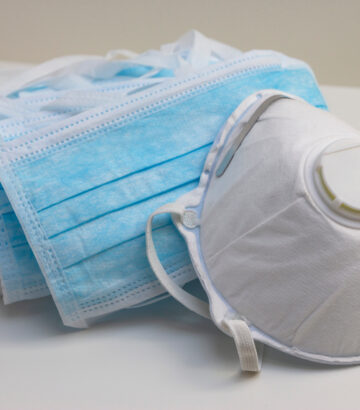Prevent Airborne Transmission in Healthcare
It is well-established that N95s offer more protection than surgical masks against breath-emitted airborne pathogens [1] and wildfire smoke [2], which are micron-size fine particles. There is no scientific argument suggesting that surgical masks are equal to N95 respirator masks in protecting against wildfire smoke. Health authorities [3] recommend respirator masks for wildfire smoke, and it is important to maintain high protection standards for airborne pathogens as well—including COVID-19, a Biosafety Level 3 airborne pathogen [4] requiring robust protective lab equipment [5], which has killed millions [6] and disabled millions more [7].
Despite abundant evidence supporting the superiority of respirator masks, the CDC advisory group HICPAC [8] (Healthcare Infection Control Practices Advisory Committee) has questioned whether N95s provide an advantage over surgical masks for protection against airborne transmission. In their June 2023 meeting [9], HICPAC claimed that data show comparable protection, while recommending surgical masks for seasonal coronaviruses, and N95s for diseases considered “novel” or “pandemic phase,” despite the fact that this distinction does not reflect the airborne transmission mechanism. They previously suggested it might be possible to declare SARS-CoV-2 as seasonal [10], even though it isn’t [11], as it’s causing substantial morbidity and mortality throughout the year, including outside of the traditional viral respiratory seasons. Peak activity is influenced by rapid evolution of new variants/subvariants [12], times of increased travel and multi-household gatherings [13], COVID-19 precautions in place, and rapidly waning immunity [14], among other factors.
Research shows allowing COVID-19 to spread in healthcare settings has severe consequences. For the past year, nearly a third of COVID-19 hospital cases in England were hospital-acquired [15]. Hospital-acquired COVID-19 had a 10% mortality rate [16]. Studies show hospital-acquired COVID-19 caused 1.5-fold higher risk of in-hospital all-cause mortality than influenza [17] and made people’s existing illnesses worse [18]. Genomic sequences during a hospital COVID-19 outbreak showed healthcare workers were responsible for much of the spread [19].
What HICPAC Claims the Science Tells Us
HICPAC’s draft proposal [9] includes a review of 13 studies, concluding that the “evidence suggests no difference between N95s and surgical masks.” This conclusion was reached despite footnotes indicating that virtually all cited studies were unreliable due to confounding variables. These include community and coworker exposures, patient mask use, recall bias, and compliance not reported or not measured objectively.
The HICPAC mask review also neglects the role of asymptomatic transmission [24] which makes it possible and likely that, without adequate respiratory protection, healthcare workers, who are under pressure to work when ill [25], will infect patients. Moreover, the studies cited do not account for patient healthcare-acquired infections, and adverse outcomes, including for vulnerable patients.
What the Science Actually Tells Us
Aerosol science explains that COVID-19 spreads through aerosol particles which can infect when inhaled. Like smoke, these tiny particles can float and travel well beyond 6 feet in the air. In indoor spaces that are not properly ventilated, they can remain in the air for hours [26], even after the source has left the space.
Respirators are more effective than masks according to many studies:
- Mask efficacy depends on airborne viral load, and high viral load, which is expected in healthcare settings where patients with illnesses congregate, makes inhaling particles emitted by others unavoidable without adequate fit and filtration, necessitating certified respirator use rather than medical masks [27].
- With only the susceptible wearing a surgical mask, the upper bound of infection risk is 90% after 30 minutes. However, when both the susceptible and infected wear a well-fitted respirator mask, the risk is 0.4% after an hour [28].
- Continuous use of N95 respirators is more effective compared to intermittent use of N95 respirators or medical masks. In a particular study the incidence of illness was 7.2% for continuous N95 use, 11.8% for intermittent N95 use, and 17% for medical masks [29].
- When medical masks were replaced with FFP3 respirators for nurses on a COVID-19 ward, infection risk declined by 52%-100% [30].
What NIOSH and FDA Tell Us
The superiority of respirators over surgical masks is supported by decades [31] of scientific research, the consensus on dominance of airborne transmission for COVID-19 [32], and by the standards of the National Institute for Occupational Safety and Health (NIOSH) [33] and the Food and Drug Administration (FDA) [34].
NIOSH [33] states: “Surgical masks are not respiratory protection: A surgical mask can help block large particle droplets, splashes, sprays or splatter … They do not form a tight seal against the skin or filter very small airborne pathogens…involved in airborne disease transmission.”
The FDA [34], which regulates surgical masks in the U.S., states [35] “surgical masks are not intended to provide protection against pathogenic biological airborne particulates and are not recommended for use in …any clinical conditions where there is significant risk of infection through inhalation exposure”, and “a filtering facepiece respirator (e.g. N95) with a tight fit is recommended to provide a more reliable level of respiratory protection against pathogenic biologic airborne particulates.”
Why Our Feedback Is Important
The CDC has lost public trust [36], acknowledged missteps, and announced a response [37], including stating [38] it would:
- “Work in partnership with others in and outside of government to turn science into public health action and results.”
- “Engage CDC Senior Leadership and decision makers in ongoing forums to receive feedback on issues and concerns from key stakeholders: State/local/territorial health officials; providers; researchers; employers; community-based organizations; policy makers; and the public.”
The CDC has yet to deliver on its promises to open up communications. The National Nurses United (NNU) stated [39] recently “Currently, access to HICPAC meetings and meeting materials is extremely limited… [for] input from health care workers, their unions, patients, or community members.”
There is no room for errors in guidance on effective PPE to protect healthcare workers and patients, especially given both short and long-term effects of COVID-19.
Failing to protect healthcare workers and patients goes against common sense and compassion, harms healthcare workers and patients, and forces patients to choose [40] between foregoing needed care or risking severe outcomes. The HICPAC’s infection control recommendations must include scientifically based protections including universal use of respirators against airborne pathogens.
Sources:
[1] N95 respirators, surgical masks, face masks, and barrier face coverings. FDA. Published online September 15, 2021. https://www.fda.gov/medical-devices/personal-protective-equipment-infection-control/n95-respirators-surgical-masks-face-masks-and-barrier-face-coverings
[2] Protect your lungs from wildfire smoke or ash, protecting your health. https://www.epa.gov/sites/default/files/2018-11/documents/respiratory_protection-no-niosh-5081.pdf
[3] Patient exposure and high particle pollution events | US EPA. (2023, May 8). https://www.epa.gov/pmcourse/patient-exposure-and-high-particle-pollution-events
[4] Working with COVID-19 Biospecimens – Center for Clinical and Translational Science | UAB. Accessed August 2, 2023. https://www.uab.edu/ccts/news-events/news/workingwithcovid
[5] Weekly SJ, Austin P, Caskey SA, Guddera N. BSL-3 General Procedures. June 1, 2007. Accessed August 2, 2023. https://www.osti.gov/servlets/purl/1148002
[6] Dashboards. WHN. Accessed August 2, 2023. https://whn.global/dashboards/
[7] Davis HE, McCorkell L, Vogel JM, Topol EJ. Long COVID: major findings, mechanisms and recommendations. Nature Reviews Microbiology. 2023;21(3):1-14. https://doi.org/10.1038/s41579-022-00846-2
[8] HICPAC | CDC, July 20, 2023. Accessed August 2, 2023. https://www.cdc.gov/hicpac
[9] IP_Workgroup_HICPAC-FINAL.pdf. Google Docs. Accessed August 2, 2023. https://drive.google.com/file/d/14s40YHjuZxMQ_ZOx2qXIdsPDxD0641_b/view
[10] Healthcare Infection Control Practices Advisory Committee, November 3, 2022. Accessed August 2, 2023. https://www.cdc.gov/hicpac/pdf/2022-November-HICPAC-Summary-508.pdf
[11] Wiemken TL, Khan F, Puzniak L, et al. Seasonal trends in COVID-19 cases, hospitalizations, and mortality in the United States and Europe. Scientific Reports. 2023;13(1). https://doi.org/10.1038/s41598-023-31057-1
[12] Zhao Y, Huang J, Zhang L, Chen S, Gao J, Jiao H. The global transmission of new coronavirus variants. Environmental Research. 2022;206:112240. doi:https://doi.org/10.1016/j.envres.2021.112240
[13] UMD Research Sheds Light on Holiday Travel and COVID. Accessed August 2, 2023. https://eng.umd.edu/news/story/umd-research-sheds-light-on-holiday-travel-and-covid
[14] Menegale, Francesco, et al., Evaluation of Waning of SARS-CoV-2 Vaccine–Induced Immunity, JAMA Network Open, 6, 5, 3 May 2023, e2310650, jamanetwork.com/journals/jamanetworkopen/fullarticle/2804451, https://doi.org/10.1001/jamanetworkopen.2023.10650
[15] NHS Statistics on COVID-19 Hospital Activity. https://www.england.nhs.uk/statistics/statistical-work-areas/covid-19-hospital-activity/; monthly analysis by Adelle Groyer at at https://twitter.com/AdeleGroyer
[16] Immediate action is needed to reduce Hospital Acquired COVID-19 Infections and deaths. Accessed August 3, 2023. https://ozsage.org/media_releases/immediate-action-is-needed-to-reduce-hospital-acquired-covid-19-infections-and-deaths/
[17] Portmann L, de Kraker MEA, Fröhlich G, et al. Hospital Outcomes of Community-Acquired SARS-CoV-2 Omicron variant infection compared with influenza infection in Switzerland. JAMA Network Open. 2023;6(2):e2255599. https://doi.org/10.1001/jamanetworkopen.2022.55599
[18] McAlister FA, Chu A, Qiu F, et al. Outcomes among patients hospitalized with non–COVID-19 conditions before and euring the COVID-19 pandemic in Alberta and Ontario, Canada. JAMA Network Open. 2023;6(7):e2323035. https://doi.org/10.1001/jamanetworkopen.2023.23035
[19] Borges V, Isidro J, Macedo F, et al. Nosocomial Outbreak of SARS-CoV-2 in a “Non-COVID-19” Hospital ward: Virus genome sequencing as a key tool to understand cryptic transmission. Viruses. 2021;13(4):604. https://doi.org/10.3390/v13040604
[20] Michael A. Johansson, Talia M. Quandelacy, Sarah Kada, et al. SARS-CoV-2 Transmission from people without COVID-19 symptoms. JAMA Network Open. 2021;4(1). doi:https://doi.org/10.1001/jamanetworkopen.2020.35057
[21] Linsenmeyer K, Mohr D, Gupta K, Doshi S, Gifford AL, Charness ME. Sickness presenteeism in healthcare workers during the coronavirus disease 2019 (COVID-19) pandemic: An observational cohort study. Infection Control & Hospital Epidemiology. Published online April 11, 2023:1-4. https://doi.org/10.1017/ice.2023.47
[22] Port JR, Yinda CK, Avanzato VA, et al. Increased small particle aerosol transmission of B.1.1.7 compared with SARS-CoV-2 lineage A in vivo. Nature Microbiology. January, 2022. doi:https://doi.org/10.1038/s41564-021-01047-y
[23] Cheng Y, Ma N, Witt C, et al. Face masks effectively limit the probability of SARS-CoV-2 transmission. Science. 2021;372(6549):eabg6296. https://doi.org/10.1126/science.abg6296
[24] Bagheri G, Thiede B, Hejazi B, Schlenczek O, Bodenschatz E. An upper bound on one-to-one exposure to infectious human respiratory particles. Proceedings of the National Academy of Sciences. 2021;118(49):e2110117118. doi:https://doi.org/10.1073/pnas.2110117118
[25] MacIntyre CR, Wang Q, Seale H, et al. A randomized clinical trial of three options for N95 respirators and medical masks in health workers. American Journal of Respiratory and Critical Care Medicine. 2013;187(9):960-966. doi:https://doi.org/10.1164/rccm.201207-1164oc
[26] Ferris M, Ferris R, Workman C, et al. Efficacy of FFP3 respirators for prevention of SARS-CoV-2 infection in healthcare workers. eLife. 2021;10. https://doi.org/10.7554/elife.71131
[27] Spelce D, Rehak TR, Metzler RW, Johnson JS. History of U.S. respirator approval. Journal of the International Society for Respiratory Protection. 2018;35(1):35-46. Accessed August 2, 2023. https://www.ncbi.nlm.nih.gov/pmc/articles/PMC7261008/
[28] Greenhalgh T, Jimenez JL, Prather KA, Tufekci Z, Fisman D, Schooley R. Ten scientific reasons in support of airborne transmission of SARS-CoV-2. The Lancet. 2021;0(0). https://doi.org/10.1016/S0140-6736(21)00869-2
[29] Respirator awareness: your health may depend on it–personal protective equipment for healthcare workers. July 14, 2020. https://doi.org/10.26616/NIOSHPUB2013138
[30] N95 Respirators, surgical Masks, face masks, and barrier face coverings. FDA. September 15, 2021. https://www.fda.gov/medical-devices/personal-protective-equipment-infection-control/n95-respirators-surgical-masks-face-masks-and-barrier-face-coverings
[31] Food and Drug Administration (FDA). EUA Letter of Authorization – Umbrella EUA for surgical masks (Reissued March 6, 2023). https://www.fda.gov/Medical-Devices/Covid-19-Emergency-Use-Authorizations-Medical-Devices/Personal-Protective-Equipment-Euas#Appendixasurgicalmasks https://www.fda.gov/media/140894/download
[32] Pollard MS, Davis LM. Decline in trust in the Centers for Disease Control and Prevention during the COVID-19 pandemic. Rand Health Quarterly. 2022;9(3). https://www.ncbi.nlm.nih.gov/pmc/articles/PMC9242572/
[33] CDC director announces shake-up, citing COVID mistakes. AP news. August 17, 2022. https://apnews.com/article/covid-science-health-public-rochelle-walensky-843cd83bf1d616846ff455f7f5f0d30d
[34] CDC. About CDC. Centers for Disease Control and Prevention. September 1, 2022. https://www.cdc.gov/about/organization/cdc-moving-forward-summary-report.html
[35] Sign the letter to the CDC and HICPAC: National Nurses United. Accessed August 2, 2023. https://act.nnu.org/letter/Urge-the-CDC-and-HICPAC-recognize-aerosol-transmission/?source=em20230710-183864&t=1&akid=183864.1517480.wunB4v&fbclid=IwAR2YkusAkg6COY4mwUqmHEgfIip7La8ghmtmsOfale347gkyBm7LoC_HCXk
[36] “It’s been a nightmare:” As COVID emergency ends, health equity activists say danger posed to vulnerable patients remains. WAMC. May 11, 2023. Accessed August 2, 2023. https://www.wamc.org/news/2023-05-11/its-been-a-nightmare-as-covid-emergency-ends-health-equity-activists-say-danger-posed-to-vulnerable-patients-remains











